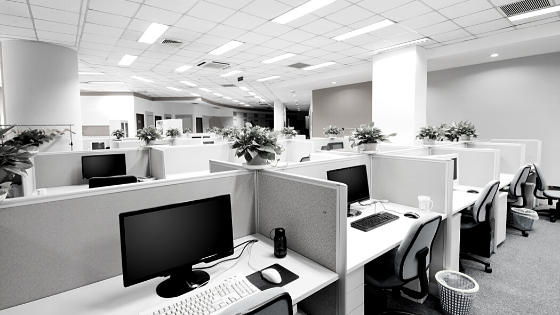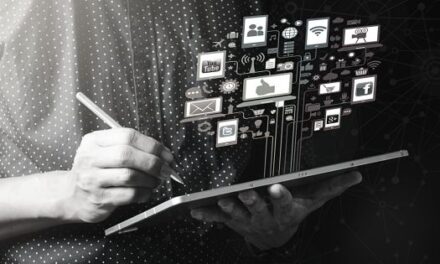Like various other workplaces, offices typically evolve to reflect social and economic trends whilst simultaneously satisfying new businesses requirements that come to the fore. Over the past handful of decades, office spaces have shifted from a cubicle-based style, to open-plan spaces that encourage collaboration, and everything in between!

In 2021, ideas surrounding office design are once again in flux and are constantly changing along four main areas:
Technology
Immersive technology can facilitate higher levels of communication and collaboration, irrespective of an employee’s physical location. Virtual reality may be the next big thing in business meetings, and augmented reality has applications for remote training, on-boarding, and product demos.
Additionally, data tracking technology is expected to turn offices into energy-efficient spaces by monitoring the use of space, lighting, heating, and cooling. The resulting data can then be used to automate systems within the office and optimise their use according to headcount, activity levels, and employee preferences.
Amenities
Wellness has become quite the buzzword in modern offices and that isn’t expected to change any time in the future. Look for offices to incorporate more spaces designed to facilitate rest, mindfulness, and physical activity. These kinds of spaces include fitness or meditation rooms, libraries, sleep pods, and calming outdoors spaces where staff can take breaks or conduct walking meetings. Overall, office design will gravitate towards increasing amenity space and achieving a more equitable distribution between spaces designed for leisure and work.
Layout
Studies have demonstrated that office layout can encourage or discourage interaction and teamwork, which in turn impacts overall productivity and job satisfaction. New office layouts will experiment with factors such as the distance between workstations, visibility, acoustics, and natural lighting. In addition, expect to see more offices combine enclosed spaces with open breakout areas and increased circulation space.
Future layouts will also blend the boundaries between work and home with the incorporation of domesticated workspace design, which mimics home spaces through the addition of soft seating, rugs, bookcases, coffee tables, etc. Some companies have already embraced this trend in the hope of increasing employee satisfaction and breaking down organisational silos.
Green office buildings
Green architectural practices can promote physical and mental wellbeing and reduce operational costs. As we move further into the 21st century, we are likely to witness growing demand for office buildings that incorporate multiple elements of green design, such as:
- Green areas (or at the very least indoor plants) that bring nature into workspaces.
- Floor-to-ceiling windows or architectural grilles to maximize exposure to natural light.
- Eco-friendly construction materials.
- Low-carbon print waste and energy systems.
AI and Office Space
AI is already being used to create smart and interconnected offices but expect to see this technology take on a bigger role in the office of the future. Considering the current strides made, it isn’t hard to foresee a near future in which AI platforms carry out pre-screening of job candidates and chatbots conduct employee onboarding and training. Similarly, AI-driven tech like robotic process automation can detect bottlenecks in workflows and suggest ways of optimising processes and manage repetitive tasks more efficiently.
As to whether AI will replace office managers, we are certainly moving in the direction of automated management that eliminates human error and detects inefficiencies around the clock. However, AI is better understood as a tool to complement human skills in certain tasks while preventing burnout, instead of replacing workers entirely.
New Types of Office Spaces
Desk pods
These are designed to promote a collaborative environment whilst simultaneously allowing for privacy when needed. Desk pods consist of groups of 2 to 4 workstations typically arranged in an L-shape and set up with partition panels.
Modular offices
Modular office design is expected to continue gaining traction due to the flexibility it provides and the way in which it fulfils the current desire for agile and multi-functional workspaces. Key aspects of modular offices include movable partitions and furniture that can be rearranged when needed.
Privacy booths
Private booths are emerging as a useful addition to open-plan workspaces that want to give employees the option to access private space when required. Standalone privacy booths have also emerged as a viable option due to their cost-effectiveness and suitability for freelancers or digital nomads. In addition, these booths have seen a surge in popularity as a result of the COVID-19 pandemic, as businesses seek to encourage physical distancing and stop the spread of the virus.
Ergonomic workstations
The increased emphasis placed on wellbeing in the workplace has brought into question traditional norms such as seated desks and traditional chairs. Recognising that office employees have different needs and responses to desk-based work, ergonomic furniture has been developed to intuitively respond to the body’s movement and to offer tailored comfort. It is not uncommon to walk into modern offices and see various types of workstations, such as standing desks and kneeling chairs.
The Impact of COVID-19 on Office Design
The measures taken to curb the spread of COVID-19 have affected the way we use physical space and posed various questions about the post-pandemic office space. If one thing is for certain it’s that accommodating social distancing and sanitation requirements will be the main theme behind the return to office-based work.
The de-densification of office space is expected to play a large role in answering this challenge and helping to prioritize health and wellbeing. As a result, many elements of design that were once considered optional additions may very well become compulsory. These elements include improved HVAC systems designed to provide better ventilation for the office environment and limit the spread of viruses, touchless solutions such as motion sensing lights and foot-operated door openers, the proliferation of antimicrobial materials in office furnishings, and overall office layouts that prioritise infection control.
Moving forward, expect to see the creation of innovative office design strategies that focus on optimising the interaction between workspaces and their occupants with the goal of creating healthier, safer, and more productive work environments.




















